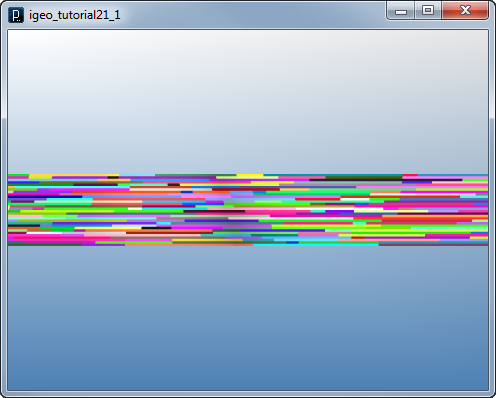

 Tutorials Tutorials | (back to the list of tutorials) |
 Panelization Example5
Panelization Example5![]()
![]()
![]()
![]()
import processing.opengl.*;
import igeo.*;
size(480, 360, IG.GL);
IG.open("surface5.3dm");
ISurface[] surfaces = IG.surfaces();
for (ISurface surf : surfaces) {
int unum = 30, vnum=40;
double uinc = 1.0/unum, vinc = 1.0/vnum;
for (int i=0; i < unum; i++) {
for (int j=0; j < vnum; j++) {
int vlen = IRandom.getInt(1, 10);
if (j+vlen > vnum) vlen = vnum-j;
IVec[][] cpts = new IVec[2][vlen+1];
for (int k=0; k <= vlen; k++) {
cpts[0][k] = surf.pt(i*uinc, (j + k)*vinc);
cpts[1][k] = surf.pt((i+1)*uinc, (j + k)*vinc);
}
new ISurface(cpts).clr(IRandom.clr());
j+=vlen-1;
}
}
surf.del();
}

And then the offset distance of the panel from the orignal input surface is randomized by the parameter depth.
![]()
![]()
![]()
![]()
import processing.opengl.*;
import igeo.*;
size(480, 360, IG.GL);
IG.open("surface5.3dm");
ISurface[] surfaces = IG.surfaces();
for (ISurface surf : surfaces) {
int unum = 30, vnum=40;
double uinc = 1.0/unum, vinc = 1.0/vnum;
for (int i=0; i < unum; i++) {
for (int j=0; j < vnum; j++) {
int vlen = IRandom.getInt(1, 10);
if (j+vlen > vnum) vlen = vnum-j;
IVec[][] cpts = new IVec[2][vlen+1];
double depth = IRandom.get(0, 1);
for (int k=0; k <= vlen; k++) {
cpts[0][k] = surf.pt(i*uinc, (j+k)*vinc, depth);
cpts[1][k] = surf.pt((i+1)*uinc, (j+k)*vinc, depth);
}
new ISurface(cpts).clr(IRandom.gray());
j+=vlen-1;
}
}
surf.del();
}


 HOME
HOME
 FOR PROCESSING
FOR PROCESSING
 DOWNLOAD
DOWNLOAD
 DOCUMENTS
DOCUMENTS
 TUTORIALS (Java /
Python)
TUTORIALS (Java /
Python)
 GALLERY
GALLERY
 SOURCE CODE(GitHub)
SOURCE CODE(GitHub)
 PRIVACY POLICY
PRIVACY POLICY
 ABOUT/CONTACT
ABOUT/CONTACT
